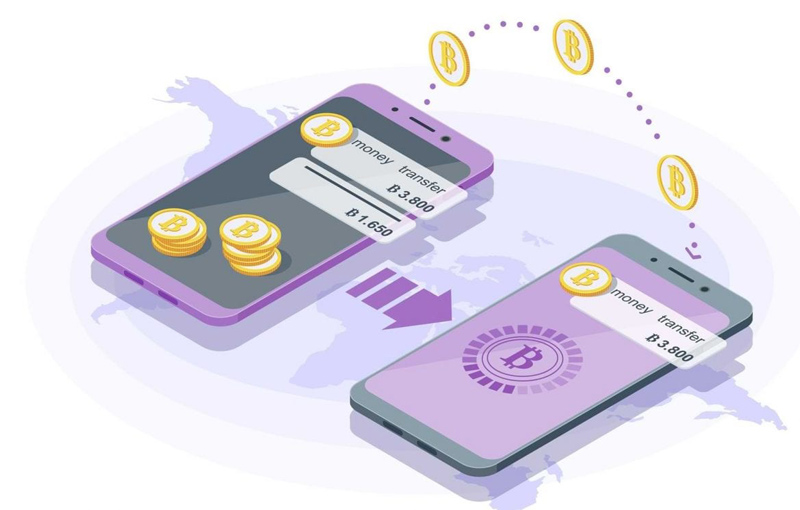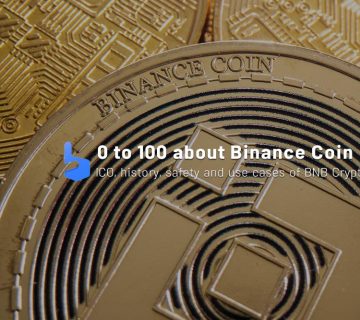What you are about to read:
Bitcoin, in simple terms, is a decentralized Cryptocurrency that encompasses the entire world within itself. It operates on a peer-to-peer system, allowing users to send and receive payments without the need for a central authority or intermediary. BTC was created in 2009 by an anonymous individual or group using the pseudonym “Satoshi Nakamoto.” Since then, it has become a widely discussed and debated topic in the realms of finance and technology. Join us in this comprehensive article from Brokerland to fully explore what Bitcoin is.
What is Bitcoin?
Bitcoin was invented by an anonymous person or group using the alias Satoshi Nakamoto. The true identity of Satoshi Nakamoto remains a mystery to this day. This currency was introduced in a white paper titled “Bitcoin: A Peer-to-Peer Electronic Cash System,” published in October 2008. The white paper outlined a decentralized cryptocurrency that enabled secure, anonymous, and fast transactions without the need for a centralized intermediary such as a bank or government.
The first transaction took place on January 12, 2009, when Satoshi Nakamoto sent 10 BTCs to Hal Finney, a computer programmer and early enthusiast of this currency. Over time, this coin gained popularity, and the number of users and transactions increased. In 2010, the first BTC exchange, BitcoinMarket.com, was established, allowing people to sell this currency for other currencies like the US dollar and the euro.
Today, it is one of the most widely used and valuable cryptocurrencies, with a market capitalization exceeding 1 trillion dollars. Unlike many other meme coins, it boasts significantly higher security and stability. While the identity of Satoshi Nakamoto remains a mystery, his invention has had a considerable impact on the worlds of finance and technology.
Bitcoin, in simple terms, is a currency that operates on a blockchain, which is a public distributed ledger. This ledger records all transactions. When a user sends BTC, it is verified by other users on the network and added to the blockchain. The blockchain ensures the security and transparency of transactions because every recorded transaction is visible to all users on the network.
This currency can be obtained through a process called “mining” which we will explain in detail shortly. Mining involves solving complex mathematical equations that confirm network transactions. When a user successfully solves a block of transactions, they are rewarded with a specific amount of Bitcoin. However, mining requires a significant amount of computational power and energy and has become increasingly difficult and expensive over time.
Another way to obtain BTC is by purchasing it from crypto exchanges. Various exchanges worldwide allow users to buy and sell the coin using traditional currencies such as USD, EUR, and GBP. Examples of such exchanges, which are secure for buying cryptocurrencies, include CoinEx, PancakeSwap, and BingX. It can also be exchanged for other Cruptocurrencies like Ethereum, Litecoin, and Ripple.
To use Bitcoin, users need a crypto wallet, a software program that enables users to send, receive, and store it. Different types of digital wallets exist, including desktop wallets, Android crypto wallets, and hardware wallets like Ledger. Each type of wallet has its own advantages and disadvantages, depending on the user’s needs and preferences.
What does Bitcoin Mining Mean?
Mining is the process of confirming and recording transactions in the Bitcoin network by solving complex mathematical problems. Mining is an essential part of this ecosystem, ensuring the integrity and security of the network.
When a transaction occurs, it is broadcast to a network of nodes, which are computers running BTC software. These nodes confirm the transaction and add it to a set of unconfirmed transactions called the mempool.
Miners then compete to confirm these transactions and add them to the blockchain, a public ledger that records all Bitcoin transactions. Miners accomplish this by solving complex mathematical problems using specialized computer hardware.
The first miner to solve the mathematical problem and add the transaction to the blockchain is rewarded with newly created BTC and transaction fees. This reward serves as an incentive for miners to continue confirming transactions and securing the network.
Mining requires specialized hardware, such as ASICs (Application-Specific Integrated Circuits), designed for the complex calculations needed to solve mathematical problems. Mining also consumes a significant amount of electricity to power the hardware, which is why many miners are located in regions with cheap electricity, such as China.
With the increasing participation of more miners in the network, the difficulty of mathematical problems rises, making mining more challenging. This design is implemented to ensure a steady creation rate of new coins, with a maximum supply of 21 million bitcoins. Sometimes, a large number of miners collaborate in what is known as mining pools to achieve this, referred to as mining or pooling.
Advantages and Disadvantages of BTC
One of the most significant advantages of BTC is its lack of centralization. Unlike traditional or fiat currencies, Bitcoin is not controlled by a central bank or government. This means it is not susceptible to inflation, manipulation, or government interference. Instead, it is governed by users on the network.
Another advantage is its ability to facilitate quick and inexpensive international payments. Unlike traditional banking transfers, which may take several days and come with high fees, Bitcoin transactions can be completed within minutes at a fraction of the cost. Additionally, this crypto provides greater privacy and security compared to traditional currencies. Since BTC transactions are recorded on the blockchain, they cannot be altered or reversed, enhancing their security compared to traditional banking transactions.
However, Bitcoin is not without its challenges. One of the most significant challenges is its scalability. As more users join the network, the number of transactions increases, potentially leading to slower transaction times and higher fees. This has prompted the development of new technologies such as the Lightning Network, aimed at improving the speed and scalability of transactions.
Another challenge is the lack of recognition by legislative bodies. While BTC is not centrally controlled by any authority, it is under scrutiny in many countries. Some countries have outright banned its use, while others have introduced regulations to ensure the safety and security of users on the network.
Despite these challenges, BTC has gained acceptance in recent years. Many major companies, including Microsoft, Expedia, and Overstock, now accept this coin as a form of payment. Additionally, several countries worldwide have officially recognized it as a legal form of currency, with some even introducing their own cryptocurrencies based on blockchain technology.
Understanding the Meaning of Buying BTC
Buying Bitcoin means exchanging traditional currencies, such as US dollars or euros, for a certain amount of BTC. It is a crypto, existing exclusively in the digital world, and can be bought, sold, and traded online. When you buy it, you’re essentially acquiring a digital asset stored in a digital wallet.
As mentioned, BTC is a decentralized currency, meaning it is not controlled by any government or financial institution. Instead, it operates on a peer-to-peer network, and its transactions are confirmed and recorded on a public ledger called the blockchain. This makes it a unique asset, not subject to regulations and controls similar to traditional currencies.
When you buy Bitcoin, you enter the BTC network and become the owner of a specific amount of this currency, which can be stored in your digital wallet. You can use it for buying or exchanging with other currencies or assets.
It’s worth noting that the value of BTC can be highly volatile, and its price can fluctuate rapidly. This means that the value of your asset may significantly increase or decrease over short periods. It’s crucial to conduct research and understand the risks before investing in Bitcoin or any other crypto.
How to Buy Bitcoin?
let’s explore how to purchase it. Over the years, acquiring and buying this currency has become much easier and more accessible. Follow these steps to buy Bitcoin:
Step 1: Get a Bitcoin Wallet
Before buying BTC, you need to have a wallet, which is an application that allows you to store, send, and receive this coin. Wallets come in various types, including desktop wallets, mobile wallets, and hardware wallets. Choose a wallet that best suits your needs and make sure it’s compatible with the platform you intend to use.
Step 2: Choose a Cryptocurrency Exchange or Broker
There are various options for buying Bitcoin through crypto exchanges, platforms that enable direct buying and selling of this cryptocurrency with other users. Some popular exchanges are mentioned above.
Step 3: Create an Account
Once you’ve chosen your preferred exchange, you need to create an account. This step typically involves providing personal information and identity documents such as a passport or driver’s license. Some platforms may require additional verification, such as a selfie or video call.
Step 4: Select a Payment Method
After creating your account, you need to choose a payment method. It could be a bank account, credit card, or cash card. Different platforms offer various payment options, so choose the one that suits you best.
Step 5: Purchase Bitcoin
Once your payment method is selected, you can buy BTC. After the transaction is confirmed, it will be transferred to your digital wallet.
Step 6: Securely Store Your Bitcoin
After the purchase, it’s crucial to securely store your coin. This means keeping it in your wallet and ensuring the safety of your wallet. You should never leave large amounts of crypto on an exchange or in an insecure wallet.
Can We Spend Bitcoin Like Money?
Yes, Bitcoin can be used to make purchases similar to any other currency. However, it’s essential to note that not all places, such as shops or service providers, accept it as a form of payment. While the number of businesses accepting it has increased over the years, it still represents a relatively small percentage of the total.
The process of spending Bitcoin is akin to using a cash or credit card, but there are some key differences. BTC transactions are irreversible, meaning once a transaction is confirmed on the blockchain, it cannot be reversed. While this can be beneficial for individuals as they don’t have to worry about repayments or fraud, it also means consumers need to be cautious when sending Bitcoin and ensure it goes to the correct address.
Additionally, transaction confirmations take longer compared to traditional payment methods, especially during peak network activity. This means receiving payment and completing a transaction may take more time.
Summary
Bitcoin is a revolutionary technology with the potential to reshape the financial and technological landscape. Its decentralized nature and secure, transparent transactions make it an attractive alternative to traditional currencies. However, it is not without its challenges, and witnessing its evolution in the coming years will be interesting.
Mining Bitcoin is the process of confirming and recording transactions on the BTC network by solving complex mathematical problems. Miners are rewarded with newly created coins and transaction fees, contributing to network security and integrity.
Buying Bitcoin involves exchanging fiat currencies for this digital asset existing on a decentralized network. The acquired BTC can be stored in a digital wallet and used for purchasing or trading with other currencies or assets. Reliable research and choosing a secure platform are crucial when buying this coin. Always store your coin in a secure wallet and avoid leaving large amounts on an insecure exchange or wallet.
Spending Bitcoin is possible, but it’s essential to research and ensure that the recipient accepts it as a form of payment. Keep in mind that BTC transactions are irreversible, so double-check that you are sending it to the correct address.














